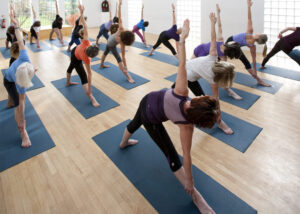What is Kapalbhati Pranayama in yoga?
Yoga practitioners come across a variety of breathing exercises throughout their journey. The breath of fire known as “Kapalbahti Pranayama” is a fast technique that involves controlled, passive inhales followed by strong, active exhales. When doing Kapalbhati (also Kapalabhati) Pranayama—(kah-pah-luh-BAH-tee prah-nah-yah-muh), the focus in the breath is on the abdominal muscles that need to be activated in order to push out the breath. Yogis say that the rapid movements of the breath help one keep balance while also removing toxins. Many call this technique Kapalbhati Pranayama, yet that is not entirely correct. The method is actually a schat kriya, which means it is a form of cleansing that removes toxic air and toxins from the body. It is one of the six Shatkarmas (cleansing techniques) of yoga as mentioned in the classic text—Hatha Yoga Pradipika, but seeing as it is a breathing exercise, it is common for it to be called pranayama.
How To Do Kapalbhati Pranayam – Steps
- Sit comfortably on your yoga mat. Choose a sitting posture that you can hold easily yet firmly. This can be Sukhasana, Padmasana, or Varayana. The location of your practice is also just as important. Make sure to get an environment that is relaxing and a place where you can focus. Now, maintain a good posture. You need to keep your body with a straight back and without any movements or tension in the neck, jaw, shoulders, and legs.
- Inhale through both the nostrils deeply, while focusing on the belly region.
- As you exhale, pull your navel back towards the spine, as much as you can. Your exhale should feel – as the name states – like you are breathing out fire or a candle; this means it should be quick, while you pull your stomach inwards. During exhalation, you should be able to hear your breath like a strong wind. When you inhale, the stomach should come outwards, and upon exhalation, it should move inwards.
- Keep focus and control of your abdominal contractions at all times. By doing the practice slowly and with a lot of focus, you can intensify your breathing accordingly.
- Try not to get too carried away. Start with a cycle of 15 exhalations first and then take few deep comfortable breaths. Do 3 cycles of 15 and observe your sensations. You can gradually build on that over time.
- Prepare your body and breath properly. To make sure that you do not create or increase physical tension in your body, be sure to warm up your neck prior to doing Kapalbhati and lengthen your exhalations with progressive abdominal contraction.
This breathing technique is advanced and should be done with precaution. We highly recommend that you learn how to do this breathing exercise with an expert.
Kapalbhati Pranayama Dangers
Rapid breathing to help relax the mind may sound strange to some and for good reason. It is true that unless you are fully aware of your state while doing the exercise, you can raise your blood pressure too high, feel nauseous, and maybe even get a hernia. It is also advised to eat at least four to five hours before starting the practice. If you eat sooner, you will have a higher probability of vomiting. Yogis suggest consulting your doctor before doing any breathing exercises. It is best to do this if you suffer from panic attacks, high blood pressure, hernias, or any condition activated by hyperventilation.
Kapalbhati Pranayama During Pregnancy & Menstrual Cycle
Just like certain asanas that are appropriate to practice during your menstrual period, there are also some yogic exercises you may want to avoid. Kapalbhati Pranayama is one of them, as it is forceful breathing and puts excessive pressure on the abdominal region, and practicing it may be the most uncomfortable, especially if you tend to bleed a lot during this time. It is also best not to practice the rapid breathing technique when pregnant. The contractions in the abdominal muscles can harm the baby.
Effect of Kapalbhati Pranayama on the brain
James Nestor wrote the book Breath: The New Science of a Lost Art. In it, he explains:
“Whenever the body is forced to take in more air than it needs, we’ll exhale too much carbon dioxide, which will narrow the blood vessels and decrease circulation, especially in the brain. With just a few minutes or even seconds, of over-breathing, brain blood flow can decrease by 40 percent, an incredible amount. The areas most affected by this are the brain’s hippocampus and frontal, occipital, and parieto-occipital cortex, which, together, govern functions such as visual processing, body sensory information, memory, the experience of time, and the sense of self. Disturbances in these areas can elicit powerful hallucinations, which include out-of-body experiences and waking dreams.”
If you have ever heard of people getting into an out-of-body, trance-like state only through breathwork, then it is highly likely that they were doing the breath of fire. It is called “skull shining” as an alternative name. Kapalbhati makes your head feel lighter making you feel “high”. Depending on the person, this can be a pleasant or unpleasant experience. Studies have also shown that people, who did the breathwork for one minute before an activity, were able to complete cognitively challenging tasks at a greater speed than without it.
Kapalbhati Pranayama Benefits
Kapalbhati is one of those complicated techniques that can either help you or harm you, depending on how you practice it. Many articles on Kapalbhati praise its potential benefits, which include clearing of the sinuses and lungs of allergens, increased metabolism, weight loss, improved circulation, and increased oxygen supply.
- Breathing is known to help to reduce the CO2 levels in the blood, thereby helping to increase the oxygen levels in the body.
- The ‘active exhalation and passive inhalation’ that is needed in this technique helps to correct the low blood circulation in the body. It also de-stresses the mind.
- It increases the capacity of your lungs and strengthens them.
- Kapalbhati is known to remove toxins.
- Pitta, the metabolic rate which is known to support weight loss, is activated.
- Brain cells are engaged thereby improving memory and concentration power. It also helps to control anxiety and tension.
- The breathing increases your blood flow and gives you a radiant glow.
- It can help cleanse the sinus.
- Practicing Kapalbhati is said to help to relieve gas, heartburn, and constipation.
- It can help you sleep better at night.
- It boosts the production of endorphins which uplift your mood.







